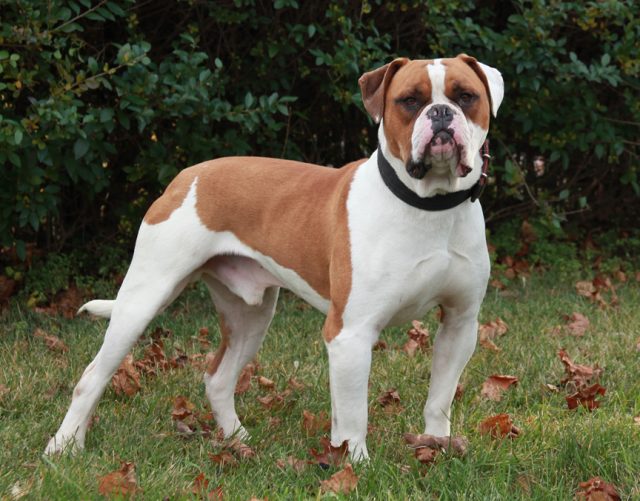Type the name of the breed you're looking for below
[wpdreams_ajaxsearchlite] Don't see the breed your're looking for? Click here and let us know!
Breed Characteristics
1 paw - breed exhibits the least amount of this characteristic
5 paws - breed exhibits most amount of this characteristic
American Bulldog
| Other Names | Old Country Bulldog, AmBulldog |
| Country of Origin | United States |
| Weight | Males: 70–120 lb (32–54 kg) Bully type: 85–130 lb (39-59kg) Females: 60–90 lb (27-41 kg) |
| Height (at withers) | Males: 20 – 28 inches (50 – 71 cm) Females: 20 – 25 inches (51 - 63.5 cm) |
| Coat | The American Bulldog's coat is short, harsh and generally smooth. |
| Colour | Colors, while historically predominantly white with patches of red, black, or brindle, have grown in recent years to include many color patterns including black, red, brown, fawn, and all shades of brindle. The color conformation is quite varied, but solid black or any degree of merle is considered a cosmetic fault, and a blue color is a disqualification by the NKC Breed Standard. Black pigmentation on the nose and eye rims is preferred, with only some pink allowed. Eye color is usually brown, but heterochromia also occurs, although considered a cosmetic fault. |
| Litter Size | 7–14 puppies average of 11 puppies |
| Life Span | 10–16 years |
| Origin & History | Even the slight modifications the bulldog underwent in Spain and England up to the Industrial Revolution (before 1835), were absent in the working strains. Most settlers of the American South came from the West Midlands of England and emigrated as a result of the Civil War between Royalists and Parliamentarians, well before the Industrial Revolution). The original bulldog was preserved by working class immigrants who brought their working dogs with them to the American South. Small farmers and ranchers used this all-around working dog for many tasks including farm guardians, stock dogs and catch dog. These dogs were not an actual breed as considered by today's standards but were a generic bulldog type. There were no recorded pedigrees or records and breeding decisions were dependent on the best working farm dogs despite breed or background. Several separate strains of the "bulldog" type dogs were kept by ranchers as utilitarian working dogs. Perhaps the most important role of the bulldog and the reason for its survival, and in fact why it thrived throughout the South, was because of the presence of feral pigs, introduced to the New World and without predators. The bulldogs were the settlers' only means of sufficiently dealing with the vermin. By World War II, the breed was near extinction until John D. Johnson and his father scoured the back roads of the South looking for the best specimens to revive the breed. During this time a young Alan Scott grew an interest in Mr. Johnson's dogs and began to work with him on the revitalization process. At some point, Alan Scott began infusing non-Johnson catch bulldogs from working Southern farms with John D. Johnson's line, creating the now Standard American Bulldog. At another point, Mr. Johnson began crossing his line with an atavistic English bulldog from the North that had maintained its genetic athletic vigor. American bulldogs are now safe from extinction and are enjoying a healthy increase in popularity, either as a working/protector dog or as a family pet. All over the world, they are used variously as "hog dogs" (catching escaped pigs or hunting razorbacks), as cattle drovers and as working or sport K-9s. |
| Personality | The American Bulldog is loyal, reliable, brave and determined. Not a hostile dog. Alert and self-confident, this breed genuinely loves children. It is known for its acts of heroism toward its master. It has strong protective instincts, and needs a firm, confident, consistent pack leader. Well-socialize and obedience train them at an early age, to prevent them from becoming reserved with strangers. Without that strong-minded pack leader who can tell the dog what is expected of it, it may be aggressive with other dogs. They need to be around people and know their place in their pack to be truly happy. This breed tends to drool and slobber. Without enough daily mental and physical exercise they will become high strung and may become hard to handle. |
Care Requirements
| Health | Some health problems in American bulldogs are often found within certain genetic lines, and are not common to the entire breed, while others, such as neuronal ceroid lipofuscinosis (NCL), Ichthyosis, disorders of the kidney and thyroid, ACL tears, hip dysplasia, cherry eye, elbow dysplasia, entropion, ectropion, and bone cancer are more common to the general population of American Bulldogs. There are DNA tests available to help breeders screen breeding animals for NCL (neuronal ceroid lipofuscinosis) and Ichthyosis. It is highly recommended to spend time to research your breeder information, including your American Bulldog's family history. A Penn Hip (Pennsylvania Hip Improvement project) or OFA (Orthopedic Foundation for Animals) screening is recommended for all potential breeding animals. Some breeds of American Bulldog are prone to allergies. Symptoms like a runny nose or a rash are examples of signs of allergies. Some vets recommend dog owners to give 25 mg of Benadryl per day; in most cases it helps. |
| Grooming | The short, harsh coat is easy to groom. Comb and brush with a firm bristle brush, and bathe only when necessary. This breed is an average shedder. |
| Feeding | American Bulldogs require a balanced, high quality diet. |
| Exercise | The American Bulldog should be taken on a long daily walk.. |
| Other Considerations | The American Bulldog will do okay in an apartment if it is sufficiently exercised. They are relatively inactive indoors and will do best with at least an average-sized yard. |



